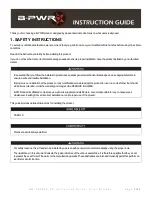
Safety
6
290163 / 949660310110
2021-08-05·BA00·III·en·00
DE
EN
FR
IT
ES
RU
NL
DK
SE
FI
PT
GR
PL
CZ
SK
HU
SL
RO
BG
LV
LT
EE
CH
KR
CN
Socket for CPU and power modules
for Zone 1
Series 9496/32
3.3
Residual Risks
3.3.1 Explosion Hazard
Despite the device's state-of-the-art design, explosion hazards cannot be entirely eliminated
in hazardous areas.
▶
Perform all work steps in hazardous areas with the utmost care at all times!
▶
Transport, store, plan, mount and operate the device exclusively in compliance with the
technical data (see the "Technical data" chapter).
Possible hazards ("residual risks") can be categorized according to the following causes:
Mechanical damage
The device may be damaged during transport, mounting or commissioning. This kind of
damage may, for example, render the device's explosion protection partially or completely
ineffective. This may result in explosions causing serious or even fatal injury.
▶
Only transport the device in special transport packaging that reliably protects the device
from external influences. Observe the ambient conditions when selecting the transport
packaging (see the "Technical data" chapter).
▶
Do not place any loads on the device.
▶
Check the packaging and the device for damage. Report any damage to R. STAHL
immediately. Do not commission a damaged device.
▶
Store the device in its original packaging in a dry place (with no condensation), and make
sure that it is stable and protected against the effects of vibrations and knocks.
▶
Do not damage the device and other system components during mounting.
Excessive heating or electrostatic charge
An incorrect setup in the cabinet, operation outside of approved conditions or improper
cleaning can cause the device to heat up severely or to become electrostatically charged,
causing it to produce sparks. This may result in explosions causing serious or even fatal
injury.
▶
Operate the device within the prescribed operating conditions only
(see the label on the device and the "Technical data" chapter).
▶
Only mount the device on clean, flat contact surfaces (no stick-on labels, labelling or the
like) of the mounting plate (bottom) and the contact surface of the modules (top).
▶
Mount and install the cabinet in such a way that all devices installed within it are always
operated within the permissible temperature range.
▶
Gently clean the device with a damp cloth only.
















































